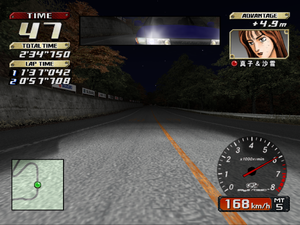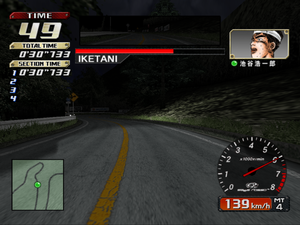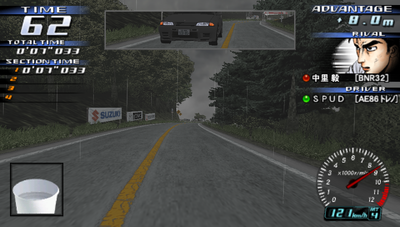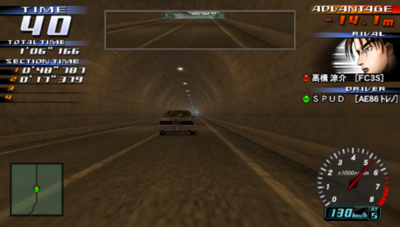Initial D Arcade Stage
♪ BGM: BACK ON THE ROCKS
Initial D Arcade Stage (usually known as IDAS followed by a version number) is an arcade racing game series based on the titular manga/anime, developed by Sega Rosso and for most of its life has been published exclusively in Japan. Originally found only in sit-down arcade machines, the games were notable for making use of a magnetic card system similar to certain other games to save the player's data, in this case car and game progress.
Gameplay is extremely arcadey, especially in the older versions, and generally consists of three or so modes- Legend of the Streets, where the player chooses a car and upgrades it through winning races while facing various friends and enemies from the series, Time Attack, which is exactly what it sounds like, and Bunta Challenge, available in certain games only, in which the player races against tofuman himself Bunta Fujiwara, the hardest opponent in the game- in the arcade games, this is the only mode where the player can actually lose points towards their car tuning. Races take place on various Japanese mountain passes (depicted extremely closely to their real-life counterparts, so if you're familiar with Mt. Haruna or Mt. Akagi from other games, you'll be right at home), and are held between two racers at a time with no traffic, although each course does have variations- uphill/downhill, inbound/outbound, day/night/weather, etc. The soundtrack is exclusively Eurobeat (that varies from game to game) with M.O.V.E. usually showing up as the opening/attract music, so there's no need to mute the game audio to play your own.
While there are eight versions (so far) of the games along with multiple ports, only a few made it to the West or are otherwise playable, so those are the ones we're really worried about here.
Contents
Space Boy: Initial D Arcade Stage to IDAS Version 3
Where it all started. The first three games are often what one thinks of when talking about IDAS, as they were not only the earliest but also the only ones with full Western releases. Gameplay and car handling is very, very far from realistic, and although the series is known for drifting, for these early games cars can't really even drift, just steer into corners really hard, although FR, FF and MR do control differently. These games run on some of the same code as OutRun 2, and as such shares some of the engine's physics quirks, such as eraser (shifting up instead of down to corner tighter) showing up in V3, but that's all crazy bullshit you'll never need unless you're some Jap guy one second away from the world record.
Each game added more cars and tracks, with the original game having only four courses and a bit over a dozen cars. Some vehicles are outright better than others (DC2), some are meant to be joke cars (AE85), and some are the best fucking car in the game once you learn how to use it (Cappuccino), but all are equally viable if you're a good enough player.
Player progression consists of going through Legend of the Streets mode and defeating opponents to gain points. At certain point levels your chosen car will receive upgrades; these will depend on the 'tuning path' chosen at the same time as the car, consisting of a set list of mechanical and visual changes. These can vary greatly depending on the car- for example, the AE86 Trueno receives an 11,000 RPM racing engine as the final upgrade in paths A and B that gives a considerable power increase but requires totally different shift points than what you've grown used to, C includes a turbocharger for more high-end power but lelturbolag, and D focuses less on engine power and more on handling and suspension. Once a tuning path is completed, you'll randomly have the option to swap out visual parts for pieces from other tuning paths, so pick the one that will give you what mechanically. Google-fu should turn up a guide or two to the various paths.
Emulation
IDAS through Ver. 3 all run on the Sega NAOMI arcade board, which is based on the Dreamcast. Until recently, it was near impossible to get them to run properly, but Demul has been updated enough that they'll hit 60fps and not crash. Both the import and export versions work- the screenshot above is from the US release of Version 3, hence the English names.
However, with glitched graphics, possible crashes, and most importantly, no card system to save your progress, it's really not worth it. The only thing one might find enjoyment in is chuckling at the different names given to some of the characters, and seeing where the recolored manga images weren't cropped properly.
Special Stage
In 2003, Sega ported Ver. 2 to the PS2 as Initial D Special Stage- exclusively in Japan, of course. IDSpS includes everything from V2 except multiplayer, unfortunately- instead, it includes fiftysomething if not more smaller 'missions' that follow the course of the manga (up to a point), less quarter munching, and a huge soundtrack consisting of just about every good or notable Eurobeat track from the first two seasons of the series, although you have to unlock some of them first. Special Stage runs at a fluid 60 frames per second with no real graphics hit from the arcade port, and isn't especially hard to run despite being a PS2 game, so if you just want to play some Initial D this is probably your best bet. PCSX2 will be your emulator of choice; finding an ISO is up to you but shouldn't take very long. (Here's a mega link; delete if you don't want this on here.)
Despite being a PS2 game, by default Special Stage only has digital controls- the analog stick doesn't activate until you hit a certain point, then it works just like the D-pad. Even then it controls quite nicely, without feeling too jerky or slow- at least until you get to Irohazaka or Happogahara and spend the entire race against the wall. The game supports a steering wheel, but PCSX2 doesn't by default- you can download a USB plugin here that will allow you to emulate a generic wheel and map it to whatever real peripheral you have, be it a G27 or an Xbox pad. It's worth using this even if you're using a controller to play- while it'll make the game feel significantly different and more on-rails, some of the later courses are nigh impossible without finer steering controls.
All this is useless, of course, without a translation guide, so here's one that should get you started. The Legend of the Streets bits aren't translated, which is a shame because Special Stage adds pseudo-animation and full voice acting to them, and there's neat stuff like certain dialogues changing depending on what you're driving, but that's okay.
Street Stage
A while later, Sega decided to do another port- this time it was remaking Ver. 3 as Initial D Street Stage on the PSP, again a JP exclusive. IDStS contains just about everything from Ver. 3, but changes the car tuning system considerably. Now, instead of gaining points when winning a race, the player is given a choice of three collectable cards. Usually they're just still frames from the manga or additional car information, sometimes even extra music to play while racing, but certain cards will allow you to upgrade your car instead. Tuning paths are still present, but this system can allow the player to fully upgrade their car much earlier in the game, as well as hoard upgrade cards if they choose to change vehicles later on and have to start over.
Street Stage unfortunately suffers in the graphics department due to being on a handheld console- the visuals take a hit, although not a huge one, but more importantly the game is locked at 30 frames per second. It's a 'solid 30' without additional drops so one can get used to it after a while, but still somewhat off-putting if the player is used to 60fps+. On the other hand, PPSSPP is a considerably lightweight emulator and Street Stage isn't a very intense game, so it should be easier to emulate than Special Stage and may look nicer in your opinion due to the PS2's inherent blurriness and PPSSPP's better resolution scaling options.
Even though the PSP has an analog nub, Street Stage has no analog control whatsoever. It does, however, include a setting in the options menu to change how hard your car will veer using digital steering- it's recommended to set this to maximum, as otherwise you won't be able to turn hard enough for hairpins and switchbacks. Less sharp curves can be navigated by 'tapping' your way around it, something that should be familiar to anyone who has used an especially twitchy car in older racing games with no analog input. Still, it takes a lot to get used to the controls, and with a higher sensitivity you'll find yourself oversteering on even the slightest corners.
Street Stage was released in two forms- fully Japanese, and a European version that includes the same game but has the instruction manual in English. It can be found here- the image list goes from most recent to earliest, so it starts on page two. IDStS also includes- gasp!- multiplayer, in the form of ad-hoc local multiplayer using the PSP's wireless.







